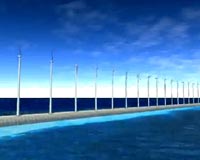 |
Oroville, Calif. (UPI) Nov 9, 2009 If the plans of innovators in the emerging high-altitude wind power sector come to fruition, huge floating helium devices and whirlybirds could be part of the aerial landscape. For the first conference on the subject at Oroville, Calif., inventors, engineers, researchers, entrepreneurs and university representatives came together from the United States, Japan, Germany, Italy, Canada and Ireland. High-altitude wind power, they say, is worth pursuing because winds aloft tend to be more powerful and consistent than winds close to the ground. "It's a somewhat early technology -- it still sounds like science fiction to most people," said conference Chairwoman Cristina Archer, an assistant professor of energy, meteorology and environmental science at California State University, Chico, the San Francisco Chronicle reports. The school was one of the conference's sponsors. Some of the models previewed during the conference: Ottawa-based Magenn Power sees possibilities for its Magenn Air Rotor System to power remote communities, such as villages in rural India or for mining operations in locations in which it is difficult to connect to an electrical grid. Filled with helium and tethered to the ground, the huge, lightweight MARS rotates about a horizontal axis in response to wind, generating electrical energy, which is transferred down the tether for consumption, or to a set of batteries or power grid. It is designed to float 1,000 feet in the air. Made of the same flexible material as airships, MARS would be easier to ship than conventional wind turbines, said Tony Asterita, one of the company's founders. MARS could be produced in a range of sizes, with larger versions able to generate 1 megawatt in steady wind, enough to provide electricity to about 750 homes. Unlike the sharp edges of wind turbines, the company says the soft surface of MARS is bird and bat friendly. "If a bird for some reason does fly into us, he would just bounce off," said Asterita. Another example of high-altitude power is Oroville-based Sky WindPower's Flying Electric Generator, which resembles a tethered elementary helicopter with no cabin. Four rotors lift the device into the air and rotate in the wind when the generator has reached the appropriate height, anywhere from 6,000 to 24,000 feet in the sky. The tether carries power to the ground and also keeps the "helicopter" in place. Larger versions of the device, said Len Shepard, Sky WindPower's chief executive, could generate up to 20 megawatts of electricity. The generator, like many high-altitude wind-powered devices, would likely require restricted airspace. Share This Article With Planet Earth
Related Links Wind Energy News at Wind Daily
 Maldives signals switch to wind power
Maldives signals switch to wind powerMale (AFP) Nov 2, 2009 The Maldivian government on Monday flagged off construction of a 200-million-dollar wind farm as part of efforts to make the low-lying archipelago carbon neutral by 2020. The wind turbine facility on a small islet just north of the capital Male is expected to be completed within 20 months, an official said, adding that it would supply more than half the nation's electricity needs. ... read more |
|
| The content herein, unless otherwise known to be public domain, are Copyright 1995-2009 - SpaceDaily. AFP and UPI Wire Stories are copyright Agence France-Presse and United Press International. ESA Portal Reports are copyright European Space Agency. All NASA sourced material is public domain. Additional copyrights may apply in whole or part to other bona fide parties. Advertising does not imply endorsement,agreement or approval of any opinions, statements or information provided by SpaceDaily on any Web page published or hosted by SpaceDaily. Privacy Statement |